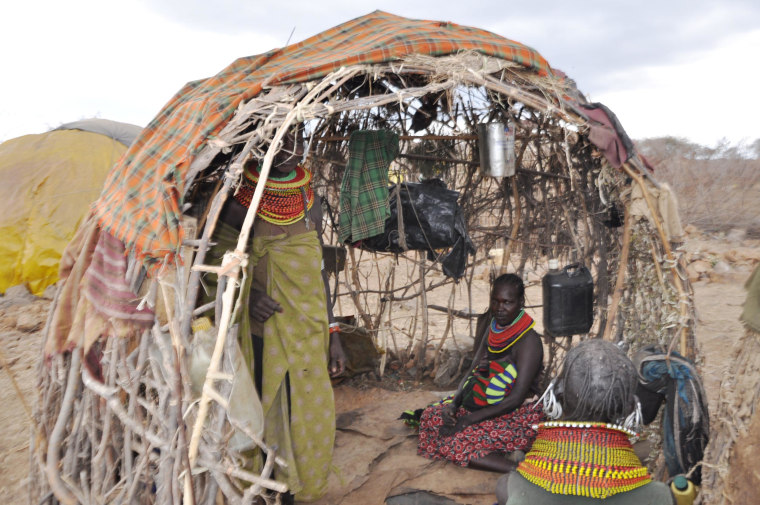TURKANA, Kenya -- The refugees stream over Kenya's border by the hundreds, desperate to escape the horrific violence plaguing South Sudan.
But their safe haven is stalked by another killer, with drought and famine contributing to a hunger crisis that has forced the living to eat stray dogs roaming northwestern Kenya's region of Turkana in order to survive.
Akaran Abaru, 73, said she recently slaughtered and roasted two canines to feed her starving grandchildren.
"I am the sole breadwinner. I can’t allow them to die of hunger," she said. "I could not beg for food because my neighbors are experiencing the same famine. And we have dogs all over the place."
Many people are going hungry now at Kakuma, a refugee camp in the remote and arid district of Turkana, according to Abdi Abdulahi, an immigration manager.
"My children and I have not eaten anything for the last one week. We have been travelling in difficulties without water and food."
"We have been trying to deal with our own hunger situation, but with the new arrivals from South Sudan things have changed. There is not enough food and medical care to cater for this entire crowd," he said.
Used as a site for refugees during the war that led to South Sudan's 2011 independence, the town of Kakuma has grown into a sprawling complex and the economic engine of an otherwise impoverished region.
The camp has swelled to accommodate 130,000 people - including the 20,000 South Sudanese who have streamed in since mid-December - and aid providers like Abdulahi warn the site is reaching its limits.
It already is 5,000 people over its official capacity, according to Abdulahi, who says more refugees are arriving every day to escape the ongoing violence in South Sudan.
The conflict erupted in December when troops loyal to President Salva Kiir fought those supporting Kiir's former vice-president Riek Machar. Thousands have died since then, while 800,000 refugees have been displaced. An estimated 254,000 have fled to neighboring countries, with around 23,000 in Kenya alone.

Pregnant Alek Bol Dau balanced her belongings on her head with her right hand and gripped her child's hand in her left as she waited in line to enter Kakuma in hopes of receiving aid.
“I have traveled barefoot for so long with my child, I have spent several nights on the way without food and water,” she said. "I only consumed water and some food three times (in the past few days) when I begged people on the way to Kakuma."
Around 70 percent of the refugees are children younger than the age of five who have been separated from their parents, camp officials said. Most are from Jonglei State, an eastern province in South Sudan where the fighting has been most intense.
Lillian Alier Deng - who had only just arrived in Kakuma - said she fled to Kenya with her 8-year-old and 12-year-old after her two older sons were killed in fighting in Bor, the provincial capital of Jonglei.
Deng said she fears rebels likely raped or killed her friends who stayed behind.
“Life has not been easy in Bor since the clashes erupted,” said Deng. “My children and I have not eaten anything for the last one week. We have been travelling in difficulties without water and food."
The United Nations has given Kenya $4.6 million to fund the camps but it’s not enough to provide for all, aid workers say.
Kenya already was dealing with its own hunger crisis in the Turkana District even before the fighting kicked off in South Sudan.
"Turkana County has a population of about 845,355 people, and half that population is dying of hunger,” wrote Turkana’s emergency management director Charles Ewoi Lokyoto in a recent report detailing how his office is overwhelmed with aid requests.
That's because intense drought has led to a food crisis, according to local health official Robert Ewoi.
"The hunger situation has been growing from bad to worse as water pans have dried up, relief supplies diminished and local residents left to fend for themselves,” said Ewoi.
He said even though people are dying, the Kenyan government has yet to officially declare a famine.
“The cause of death in this area is mostly brought about by hunger and poor health,” he said. “Hunger drives these families to feed on wild fruits and drink unclean water, which is also hard to get here.”
In some villages, the government provides children with food at school and meals distributed at local police stations in the early evenings - but it isn't much.
“We can only be able to provide one meal per day because we don't have enough food here,” said Sode Chengo, police commander of Marti Village. “We only target children as they are mostly affected and can’t search for food and water on their own.”
While refugees are streaming into Kenya, hunger is forcing Kenyans to get on the move, too.
After journeying for days in hopes of finding food at a relative’s house, Napaeni Mukunyo, 65, returned home to Turkana to find that two of her children had died while she was away.
"Part of my family had starved to death,” she said. “I have not had proper cooked food or water for close to three months now. We only feed on wild fruits because we have no other option."